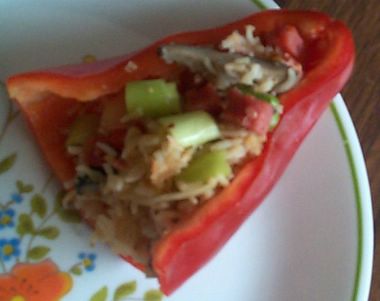Saving Money On Party Snacks - Savoury Grated Zuchinni Potato Mozarella Veggie Comfort Burgers
 I was watching Chef Emeril yesterday, pancake day, and he made fascinating looking Goat Cheese-Stuffed Zuchinni Pancakes. But while I don't mind goat cheese once in a while, I prefer the heavenly gooey chewiness of melted bocconcinni mozarella. So here's a more savoury, high-protein variation on Emeril's recipe using chickpea flour mixed with white flour, and both zuchinni and potato. Apologies for the inexact measurements. I also skipped the baking soda in Emeril's recipe, but if you want an airier texture, put 1 teaspoon.
I was watching Chef Emeril yesterday, pancake day, and he made fascinating looking Goat Cheese-Stuffed Zuchinni Pancakes. But while I don't mind goat cheese once in a while, I prefer the heavenly gooey chewiness of melted bocconcinni mozarella. So here's a more savoury, high-protein variation on Emeril's recipe using chickpea flour mixed with white flour, and both zuchinni and potato. Apologies for the inexact measurements. I also skipped the baking soda in Emeril's recipe, but if you want an airier texture, put 1 teaspoon.Ingredients
- 1/2 cup grated zuchinni, after wrapping in kitchen towel/ cheesecloth and squeezing out the water.
- 1/2 cup grated potato. You can leave the skin on if you like, but it's probably better to remove it. To reduce cooking time, you can also add roughly-mashed cooled boiled potatoes (i.e., just potato, no cream, milk, etc.).
- 3 canned shiitake (or other) mushrooms, finely minced.
- 1/2 small onion, grated.
- 1 tbsp Mom's secret garlic ginger paste.
- 1 tbsp ground cumin
- Salt and black pepper to taste
- Sprinkle of crushed red pepper flake [optional].
- 1/2 cup flour
- 1/4 cup chickpea flour for protein. It's known as "besan" in East/West Indian and Pakistani stores, and gram flour in Italian and regular grocery stores. You can grind your own from dried chickpeas if you can't find the flour.
- 2 eggs, beaten
- 2-3 tbsp olive oil
- 1 tbsp butter
- 3-4 small (bocconcini) mozarella balls, sliced thinly but without falling apart. These are popular enough these days that any good cheese shop, Italian market, or even the deli counter at a large supermarket will have them. You can substitute bufffalo mozzarella, but it's more expensive. If you can't get either, regular grated or sliced mozarella will work as well.
- In one bowl, combine all of the above ingredients down to the red pepper flake.
- In another bowl, combine the flours then the egg. You want a fairly pasty consistency, so you may need to add a bit more water.
- Now combine all of the ingredients together. With a large spoon, scoop up some mixture and see whether it'll fall off the spoon. If not, add 1-2 tbsp of water and mix.
- Heat a skillet or non-stick frying pan on medium high with the olive oil and butter.
- When the butter has melted, turn the heat down to medium high.
- Cook in batches: Ladle a heaping tablespoonful of mixture into the hot oil, and dab it down to flatten into a disc. Place a slice of bocconcinni cheese in the center of the disc. Now ladle another spoonful of mixture on top to cover the cheese. Cook for 2-3 minutes, then flip over. Cook 2nd side for about 2 minutes. (Chickpea flour needs to be thoroughly cooked.) Repeat for each burger.
Presentation
You can serve these pancake/burgrs like Emeril did, on a chunky tomato sauce or salsa, or with a dollop of sour cream, or with a slice of tomato on a burger bun.
(c) Copyright 2005-present, Raj Kumar Dash, http://cookingforone-or-two.blogspot.com























